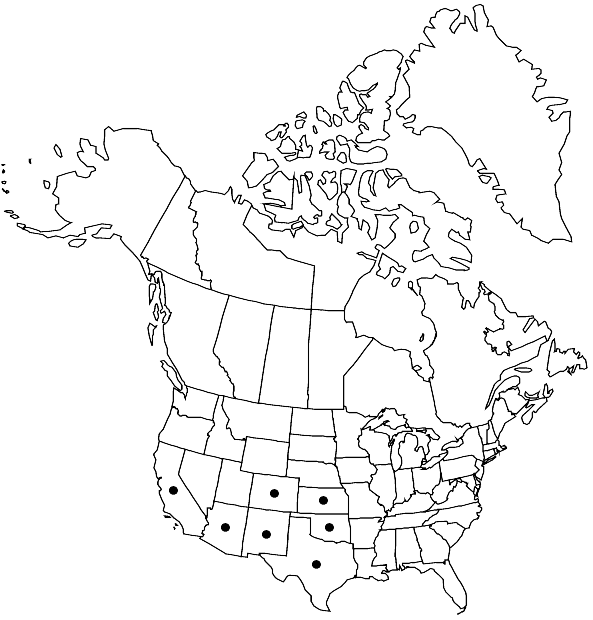Grimmia arizonae
Rev. Bryol. 19: 85. 1892,.
Plants in hoary tufts, olivaceous to dark blue-green. Stems 1–3 cm, central strand strong. Leaves ovatelanceolate, 1.5–3 × 0.6–0.7 mm, keeled, one margin recurved proximally (occasionally both), sheathing, awn 0.5–1.5 mm, costal transverse-section prominent, reniform to semicircular; basal juxtacostal laminal cells long-rectangular to linear, sinuose, thick-walled; basal marginal laminal cells short-rectangular, straight, thick transverse and thin lateral walls, hyaline; medial laminal cells short-rectangular, sinuose, thick-walled; distal laminal cells 2-stratose, not bulging, marginal cells 2-stratose, not bulging. Sexual condition dioicous, perichaetial leaves not enlarged. Seta straight, 0.5–0.7 mm. Capsule occasionally present, immersed, yellow, oblong-ovoid, exothecial cells quadrate, thin-walled, stomata present in 2–3 rows, annulus of 2 rows of rectangular, thick-walled cells, operculum long-rostrate, peristome present, perforate in middle, split in distal half.
Habitat: Exposed, dry, basalt and acidic granite, rarely on sandstone
Elevation: high elevations (1800-2700 m)
Distribution

Ariz., Calif., Colo., Kans., N.Mex., Okla., Tex., Mexico
Discussion
Grimmia arizonae is endemic to the American Southwest and northern Mexico. It has a highly restricted distribution in North America, being found in mountainous areas in southeastern Arizona to the Rocky Mountain Front Ranges of western Texas, New Mexico, and Colorado. It has disjunct sites in western Oklahoma and central California.
Grimmia arizonae is part of a group that includes G. longirostris and G. pilifera. Its sheathing leaf bases, dioicous sexuality and immersed capsules will separate it from G. longirostris. The separation of G. arizonae from G. pilifera, however, has often proven problematic. Grimmia pilifera has been described as having strongly keeled leaves and margins 2–3-stratose, thicker than the medial lamina. (e.g., H. A. Crum 1994c). H. C. Greven (1999) added usually with short-awned, ovate-lanceolate leaves. Grimmia arizonae has less keeled leaves and margins 2-stratose, not thicker than lamina. Greven noted its usually long awns and broadly lanceolate leaves. J. Muñoz (1999), however, synonymized these species, attributing any differences to geographical variations and sexual development. He reported that in eastern North America, and in shade, G. pilifera has long, acuminate apices and distinct ovate bases. In the West, and in sun, its leaves are lanceolate and without distinct bases. We would call these specimens G. arizonae. To Muñoz, the presence or absence of a central strand, is “too variable to be reliable;” he reported that fertile stems have a distinct strand, sterile stems have none. In contrast, in the present study, Hastings found the stem central strand reliable to separate these species. There is no correlation between sexual maturity and strand development; specimens of G. pilifera lack a central strand. Further, the stem epidermis is consistently twice as thick as it is in G. arizonae. Hastings found western specimens, in full sun, that lack a central strand typical of eastern specimens named G. pilifera. Many sterile specimens from Arizona have a central strand, but sterile or fertile, specimens in eastern North America do not have one. Based on these observations, G. arizonae and G. pilifera are not synonymous. Grimmia arizonae differs from G. pilifera by having a central strand, a thin epidermis, and 2-stratose distal lamina with 2-stratose not-thickened margins.
Selected References
None.
Lower Taxa
"thin" is not a number.